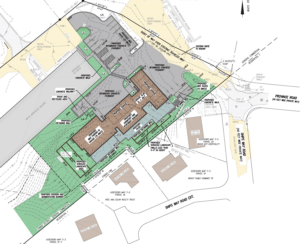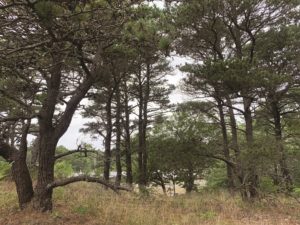PROVINCETOWN — Both supporters and opponents of the dormitory-style housing project scheduled for review by the zoning board of appeals at its Sept. 17 meeting agree on one thing: it’s hugely significant. Given that it could house 112 seasonal workers and 16 to 32 year-round residents, and is 54 yards long, it’s not hard to see why it generates strong opinions.
Many of the public comments submitted in support of Patrick Patrick’s proposal to build a dormitory on his family’s land cite the dire lack of worker housing.
“Our town’s viability is at stake,” wrote business owner Julie Knapp. “We need summer staff, and there is just nowhere for them to live. Please consider this project as essential to our survival as businesses.”
“We agree that the greatest immediate threat to the sustainability of Provincetown is the shortage of housing,” wrote the Provincetown Business Guild. “Worker housing is a number one priority in Provincetown,” the economic development committee wrote.
Abutters and neighbors of the proposed building speak in equally strong terms about the impact the building could have. The density of people, the traffic, the noise, and the physical scale of the building have sparked outrage in the people who would be living next to it.
On Sept. 17, or at a later meeting, if the hearing is continued, the ZBA must decide whether to grant three special permits. If it does, the project would then go to the planning board.
Special Permits
The ZBA process tends to be highly technical, based on zoning rules. Broader questions, about congestion or noise, are normally deferred to the planning board.
Of the three special permits Patrick Patrick is requesting from the ZBA, one is to have 20 parking spaces instead of 49, as would normally be required of a development this size. The second would allow him to fully dormer the third story instead of the usual 50 percent under the “two-and-a-half story” formula. The third would authorize a “deviation from scale.”
At the upcoming ZBA meeting, expect to hear a lot about “scale.”
Scale is used to quantify a building’s overall “bigness” — its total volume. The zoning bylaw allows a new building to be scaled 25 percent larger than the “neighborhood average.” Anything beyond that requires a special permit. Patrick’s dormitory would be 940 percent larger than the neighborhood average — that is, about 10 times bigger than the houses near it.

Special permits are not uncommon. But the people who live nearby expressed shock at a departure of this magnitude.
John Brady lives in one of the houses next to the project; he hired local lawyer Robin Reid to represent him before the ZBA.
“Some [ZBA] members were more concerned about, ‘Is there enough bicycle parking?’ ” Brady told the Independent. “And we’re sitting here saying this is 900 percent bigger than any dwelling in the neighborhood.
“I understand that the town has a problem with workforce housing,” he continued. “I think distributing workforce housing throughout the town is less impactful.”
John Stafford also lives nearby; he and Brady are both members of the newly formed Shank Painter Heights neighborhood association.
“This building is so proportionally out of scale to why we all chose to live in this neighborhood,” said Stafford. “This is an 80 percent owner-occupied year-round neighborhood. We are all in our 50s and 60s and 70s and 80s. … We are year-round residents with the notion that for the next 40 years we are going to be year-round residents.”
John Crowley lives in the house next door to Brady’s; he grew up in Provincetown and has worked at Spiritus and Bubala’s for nearly 30 years. It took him five years to build his house on an empty parcel of land he bought in 1995.
“We have rules,” said Crowley. “You can read the rules and anticipate what can be around you. This isn’t something I ever imagined.”
The Zoning Map
The ZBA calculations compare the scale of Patrick’s proposed building to abutting residences — but Patrick’s lot isn’t residential. It’s beyond a line that separates the “general commercial” zone around Shank Painter Road from the “residential 1” zone around Ship’s Way.
Stop & Shop, Cumberland Farms, Mac’s Fish House, and the Province Landing affordable housing development are all nearby in the general commercial zone. The bylaw explicitly lists dormitory or employee housing as a permitted principal use in the general commercial zone.

Patrick’s proposed dormitory would have a volume of 203,192 cubic feet. An existing building on Patrick’s property — a warehouse with artists’ studios — has 150,000 cubic feet. But “neighborhood average” calculations always discard the largest and smallest nearby structure: in this case, the warehouse and another nearby residence. Thus, the “neighborhood average scale” is the average of two nearby houses, 21,632 cubic feet.
These are the rules, but the ZBA can issue special permits that deviate from them.
Brady, Stafford, and Crowley each said they do not dispute Patrick’s right to use and make money from his property. They agree that the land is zoned for commercial use. Stafford noted that other neighboring commercial properties don’t generate much noise at midnight or later, when seasonal work shifts might end. Though public comments to the ZBA have mentioned density, congestion, light pollution, and noise, those are typically planning board issues.
Stafford also questioned whether high density housing makes sense in a pandemic or post-pandemic world. The 28 dorm rooms, accommodating 112 people on two floors, share one common kitchen, and Patrick’s diagrams don’t show much usable outdoor space.
“That is something we will certainly get into with more detail and finesse as we get into site plan review [at the Planning Board],” Patrick told the Independent. “We do have a landscape architect coming on board, who has done designs for workforce housing before. They will work on things like visual screening, acoustic screening, making it look pretty. The fact that the patio is 10 feet below grade, you’ve already done a ton of acoustic screening, just using the terrain.”
Communications between Patrick and the neighborhood association have been almost entirely conducted through lawyers since sometime in February or March, according to Patrick. The ZBA’s decision, when it comes, could be contested by either party in land court. In that case, we may not know about the project’s prospects for quite some time.



